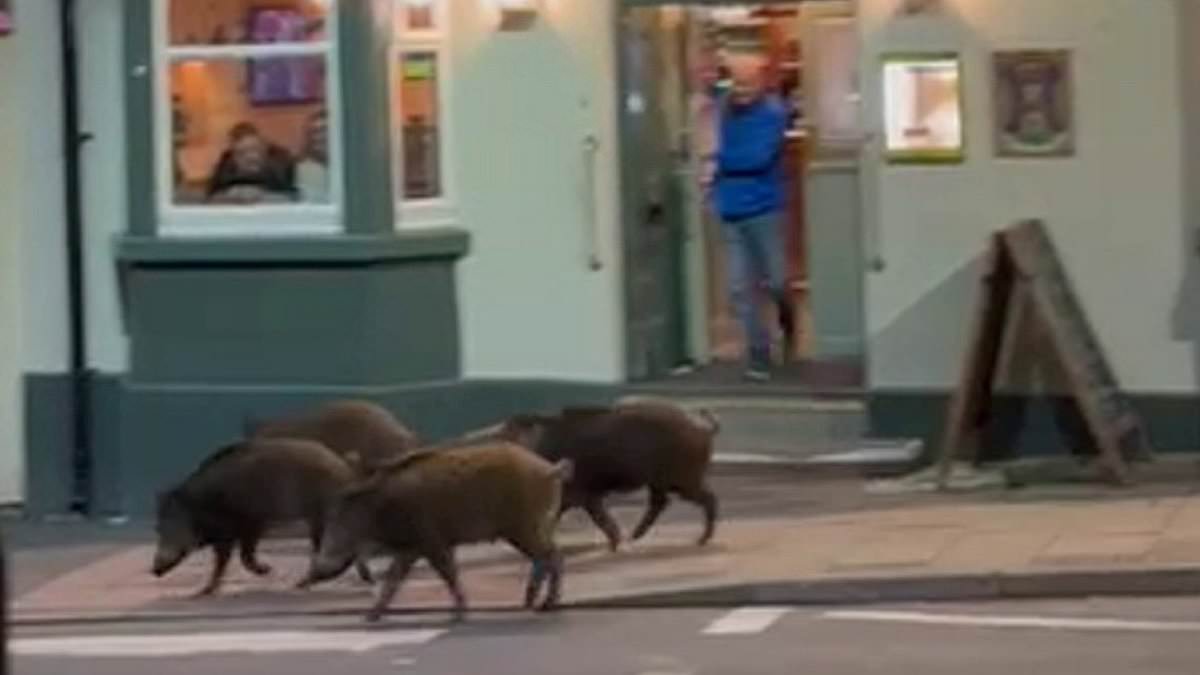This is the moment a group of wild boars were spotted strolling past a town centre boozer on a night out.
The five pigs were seen trotting past The Golden Lion in Cinderford, Gloucestershire, which is near the biggest population of boars in the UK – the Forest of Dean.
The boars in the forest have been attacking pets and dog walkers, and have even learned when bin day is – so they can come into urban areas and rummage for food.
Landlady Nikki Norman explained that it is ‘quite normal’ for the animals to roam around town due to its proximity to the forest.
She said: ‘Costumers love it – they think it is really great.’
Wild boar were hunted to extinction in Britain 700 years ago but began returning in the 1990s after captive animals either escaped or were illegally released.
Over time the boar have become more tolerant of human interest. In the past they would disappear into the woods at the sight of people, but many now continue foraging for food even when walkers are nearby.
Wild boar are stocky, powerful animals covered in bristly hair that can vary from dark brown almost black in colour to gingery brown.
They can weigh up to 220lbs, heavier than the average man, and stand around 2.6ft tall at the shoulder, the same height as a Great Dane.
When fully grown a wild boar weighs around 20 stone and can jump 6ft.
A record-breaking wild boar weighing an estimated 518lb was shot in Herefordshire in 2008.
There have been reports of dogs, cats and people being attacked by the animals, with one man having a finger bitten off in the Forest of Dean in 2018.
In 2015 there were believed to be more than 1,500 wild boar roaming the Forest of Dean – triple the amount in 2011. They originally established themselves after escaping from a wild boar farm near Ross-on-Wye, Herefordshire, in the 1990s.
In 2004, around 60 of them were illegally dumped near the village of Staunton.
By 2009 the two populations had merged and began breeding, with each sow producing up to 12 piglets a year. They have been blamed for at least 49 car crashes and countless ruined gardens.
Children have been told not to venture into the woods for fear of being mauled.
The Forestry Commission previously vowed to reduce the population with an annual cull, but numbers remain high.
The grazing animals have a rough, dark top coat of fur and their young are a paler colour which darkens with age.
While not naturally aggressive, the animals have been known to become territorial and confrontational if people, or dogs, get too close.
Boar have been commonplace across Eurasia for thousands of years and regularly hunted for sport.
King Philip IV of France died in 1286 after falling from his horse when a boar he was hunting charged at his steed, spooking the animal.
The animals have also been spotted wandering into nearby towns and villages on refuse collection days to scavenge for food scraps.
Wild boar are among several species that are being left to their own devices in the wilderness of the UK.
Recent rewilding projects are trying to bring back more of Britain’s lost fauna, including larger animals and predators, such as wolves, lynx, bison and beavers.
The latter two have been successful, with bison set to be reintroduced in Kent soon and beavers thriving in the South-West.
There is more opposition to predators, however, with farmers and the public less embracing of seeing wolves and lynx roaming the hills.
